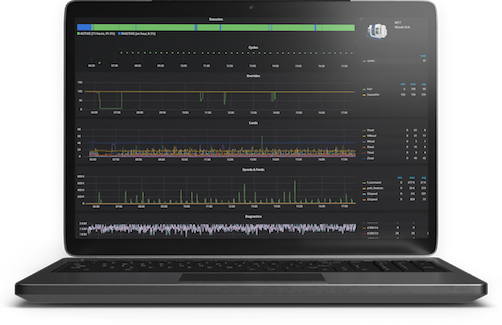Platform Leverages High-Frequency Data to Avert Failures
MachineMetrics HF collects data at 1 kHz directly from a CNC machine’s controls without using sensors. The data can immediately be used as inputs to time-series or machine learning models to predict machine and tooling failures.
Posted: September 29, 2020
Leveraging high-frequency data on spindle load to determine when the tools will fail, North Carolina machine shop BC Machining can now detect a tool failure with 99% confidence up to 40 minutes before it fails. Via MachineMetrics HF data adapter, MachineMetrics (Northampton, MA) is actuating the machine to perform a Feed-Hold when this algorithm is triggered to stop the breakage from happening.
Designed to accelerate predictive analytics use cases for machine tools, MachineMetrics HF collects data at 1 kHz directly from the control of CNC machines without using sensors that can immediately be used as inputs to time-series or machine learning models to predict machine failures. Custom algorithms deployed to MachineMetrics Edge devices process and analyze the data. When an algorithm is triggered, the solution alerts the operator or automatically stops the machines before failure.
MachineMetrics HF enables manufacturers to:
Diagnose machine problems. While low-frequency data can accomplish condition-based monitoring, condition-based monitoring on, say, spindle load requires higher fidelity. Collecting high-frequency data from the control enables diagnoses that were once impossible.
Optimize tool life. Pushing cutting tools too hard leads to high tooling costs and frequent downtime for changeovers. Not pushing machines may reduce tooling costs at the expense of throughput. An increase in tool wear due to differences in material, environment, and cutting can be detected, allowing you to run your tools to full life every time.
Predict quality issues. Compromised tools don’t do their job correctly, causing problems like bad finishes and incomplete cuts on parts that must then be scrapped once they make it to QA. Reduce these issues with tool chatter detection. Predict when parts go out of spec before they need to be scrapped or when parts will soon become out of spec.
Predicting tooling failures. Tools snap when they become over-stressed, breaking not only that tool but those further down the line. Detect when initial stress fractures are occurring and alert the operator to take them out of commission before it gets worse.
PLAY VIDEO: MachineMetrics Explainer Video





